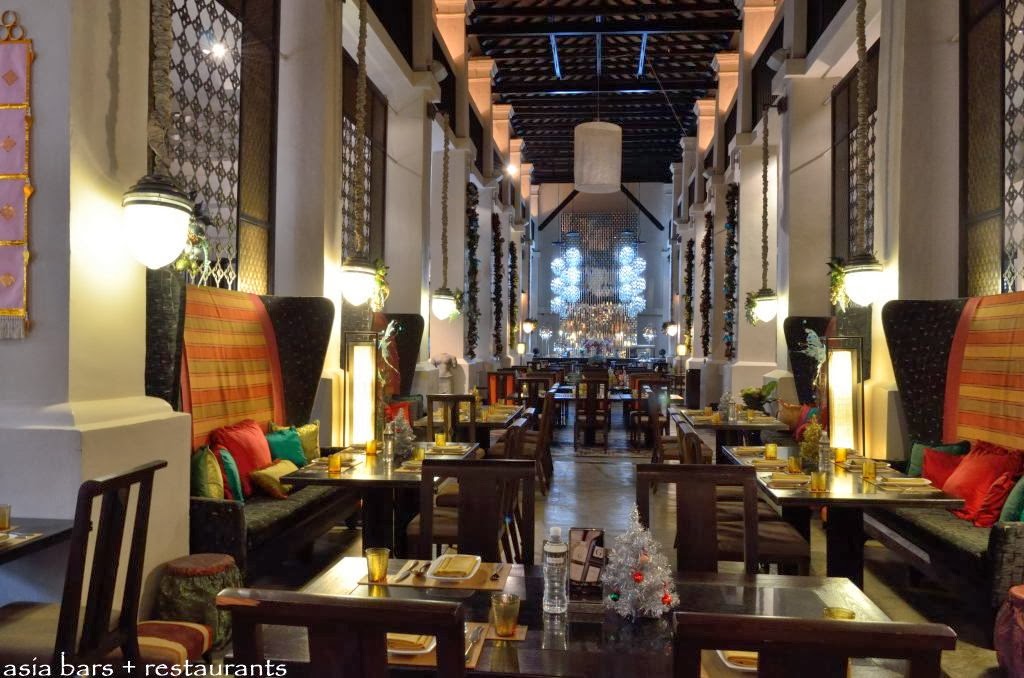 |
| The opening page of my Moleskine Japanese Album |
The last time I visited Singapore was on my way to Australia in October 1987. It struck me as a rather dull, over regulated kind of a town - rather self-conscious and insecure. There were $1,000 fines for anyone dropping litter and there was an uncomfortable contrast between the expensive shops of Orchard Road and the crowded tenements just a few streets away.
Raffles hotel was very shabby. The crumbling courtyards were scattered with rotting cane armchairs and while it had a certain air of faded elegance and was evocative of a former age of prosperity, it was a bit down at heel and sad.
 |
| Jim Thompson restaurant |
Twenty-six years later Singapore has grown up into a modern, clean, exciting city that is dripping with bougainvillea from every balcony, bridge and flyover. The streets throng with people of every nationality and the avenues are lined with the most beautiful rain forest trees. The variety of modern architecture in this 21st century city is remarkable. There are acres of polished granite and green tinted glass.
 |
| Dancing girl a Thai recipe |
 |
| Buffalo Road fruit and veg |
We ate at local food courts that are so typical of Singapore. You can get all the best flavours of China, Hong Kong, Malaysia, Thailand, Hainan, Singapore and Vietnam and all for very little money. We dined at great restaurants like Jim Thompson and the courtyard at Raffles and enjoyed old fashioned Dim Sum in China Town where ladies still vend food from their steel trollies. Hiu-yen cooked (of course) and her family brought enough dishes to feed a small army when they gathered at the Changi Bungalow.
 |
| a section of the city map showing the route we took |
Singapore has managed to conserve large pockets of its less fashionable districts and allowed the communities to stamp their own personalities on it. Little India is quite a large neighbourhood of old shop houses that have been painted in bright colours reflecting the culture of the residents and shop keepers. It is a bustling, noisy chaotic district that was supercharged by the Deepavali street lights and seasonal decorations available in the jam-packed shops and markets.
 |
| Emerald Hill |
Emerald Hill is a more upmarket remnant of the wealthy merchants who were trading goods around SE Asia. This area first started as a nutmeg plantation and began to be developed for housing in the 1890s. most of the existing terraces were built in the 1930s but seem to be styled from an earlier age.
 |
| Rain Tree and the Ubin Island ferry |
We left the beautiful home of friends in Holland Village and moved east to Changi Point to spend a fews days at Aloha Changi resort in one of the disused RAF officers' houses; built in the 1960,70 and 80s. They are set amid unspoilt grounds of rainforest trees and other plants and the morning air is filled with the shrieks of tropical birds and the constant
trill of cicadas. This huge Rain Tree, with its Bird Nets Ferns and creepers. I got the distinct feeling that if the gardeners didn't turn up for a few weeks, the rainforest would quickly take over again and the few buildings would be lost from sight. |
| Our bungalow |
Singapore Changi airport is situated close to the point and that whole district is still littered with the military and trading remnants of British occupation that was started by Sir Stamford Raffles back in 1816.
 |
| Old Changi Prison |
Another poignant relic is part of the original wall of the infamous Changi Prison which still stands as a memorial to all those who lost their lives at the hands of the Japanese army that occupied the island for three years during WW2
 |
| Map showing the route from Holland Village to Fairy Point |
 |
| Geoff and Hui-yen wander through the mangroves |
We took a trip across the straits to Ubin Island and took a tour on foot and in a little van around this nature reserve. The most enjoyable part was the walk we took along a raised boardwalk through mangrove swamp, water coconut groves and out onto the sea where we could look down upon coral beds. It was so beautiful.

For another perspective on life in Singapore, I spent Friday 18th October 2013 in a doctor's surgery followed by a trip to A&E and the Opthamological Dept of Changi General Hospital. I was taken there by a taxi driver who has definitely missed his calling as a tour guide.
He drove past the Changi museum , the massive gun built to defend the island from invasion from the sea ( the Japanese came overland from behind!), the prison, the army barracks and so on. He was full of personal memories and urban myths. It was he who told me uncomfortable stories about the Prison wall and then revealed that the Japanese high school's proximity to the prison was no planning error and so on! He certainly kept me amused. But then he revealed the local name for Changi General Hospital......... CGH .... which stands for 'Can't Go Home'!!!!!! It seems the Singaporeans love to use the initials of the big institutions on the island to make up new names!

Well, I was very well looked after by the doctors and staff there. It was a super modern facility where the A&E department felt more like a shopping mall than a medical facility. The lovely receptionists all wear pink outfits, the same colours as the beautiful bougainvillea that decorates the whole city.
I had a wonderful week with some remarkable people who I will never forget. Thank you all for your generous hospitality, delightful company and for sharing your city with me. I will be back soon.